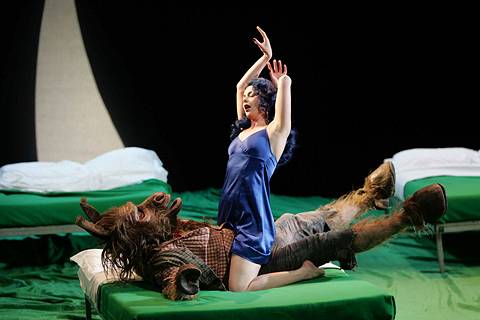|
<< -- 3 -- Robert Hugill HAUNTINGLY BEAUTIFUL

The fairies (soloists and chorus) were all played by Trinity Boys Choir, rather relishing Carsen's concept of them as be-moustachioed and slick haired gentleman's gentlemen. But the production originated under festival conditions and I am not sure that repertory revival gave the boys sufficient time to master Carsen's prescribed co-ordinated, block movements. More serious, some of the choreography meant that the boys were unable to see the conductor properly when singing, leading to coordination problems between pit and stage. But these small points apart, the choir sang and performed well. They were called upon to be more than mere spectators of the action and entered in with a will. The four treble soloists (Alexander Main-Ian, Robert Grisbrook, Christopher Kallend, Sanjeevan Ahilan) were assured both musically and dramatically.
Victoria Simmonds and Alfred Boe made a good start as the first pair of lovers, Hermia and Lysander. The music for all the lovers in this act is substantially serious. But Hermia and Lysander's first scene was gradually marred by a reliance on sight gags and physical comedy. This was exacerbated when Lynda Richardson and Leigh Melrose appeared as Helena and Demetrius. They were presented as comic characters from the start and in Richardson's case she was hampered by an unfortunately ridiculous appearance, so that whereas Victoria Simmonds did have time to make a good impression as Hermia before comedy took over, Richardson was never really given a chance. Boe made an attractive Lysander though his voice was apt to be rather steely and when he was allowed to sing without visual distraction, Melrose made a good impression. By Act II, the lovers' scenes degenerated into pure physical comedy in which Britten's music seem to come a poor second, this was especially true of the fine ensemble when the four lovers quarrel. This was a shame as all four had fine lyrical voices, of sufficient size to make an impression in the Coliseum; it was a pity they were not given more chance to show their musicality.

Peter Rose (Bottom) and Sarah Tynan (Tytania) in 'A Midsummer Night's Dream. Photo © 2004 Bill Cooper
|
This emphasis on physical comedy applied to the mechanicals as well, but here it seemed to feel less out of place, even though it was not always welcome (by this reviewer at any rate). Peter Rose made a fine, subtle Bottom; in fact in the hands of this fine singing actor Bottom sometimes seemed to be less overstated than usual. Rose managed to remain expressive even when he was covered by the full head donkey mask. But Bottom's transformation did not just run to an ass's head, hands and feet were transformed into hooves and the padding in his left trouser leg gave new meaning to the phrase 'hung like a donkey'. The mechanicals worked well as an ensemble, Christopher Gillett was a naïve Flute, Graeme Danby a bustling, in control Quince.
Continue >>
Copyright © 15 July 2004
Robert Hugill, London UK

|

